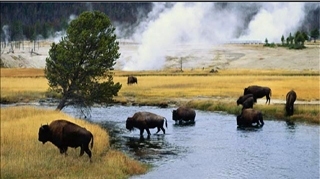|
Sweetwater
Location:
County has six townships per row, Beaver is in top tier, fourth from left
Sweetwater is in the center of Beaver
township.
Originally on Beaver Creek, which
winds through the township; possibly on south side of creek
Site of McGee Ranch
When the railroad was built Henry
Beyer, operating the general store, moved a half mile north to the south
side of the tracks.
A short time later the town was
platted on the north side of the tracks in a triangle

- In the northeast corner of Section 4
- In V formed by Sherman County line on north & Beaver Creek angling
south
- Section line on the east side
- Railroad running northwest out of the county on south west side
- Three north-south streets
- One east-west street one block long across the largest rectangle (on the
east side of town).
- The street on the north edge if town was Sherman St., the Buffalo/Sherman
county line
Name:
1) a wagon upset in Beaver Creek spilling sugar, or
2) the water in this stream was less
alkaline, therefore sweeter, than other water around.
Beaver Creek –
Flows southeast out of Sherman County into Buffalo County
Empties into South Loup at Ravenna.
Very winding
Had sandy bottom in early days
Now called Mud Creek
Bridge over Beaver Creek – Logs across the creek were covered with poles
and brush, then hay, sod and dirt.
It would serve until the next flood.
Now a historic bridge built in 1909, Pictured in book Historic Bridges of
Nebr.
Early Settlers: (Settlement in area began about 1873)
The Crostons – Civil war vet
from Maryland
He married (eloped with) a southerner.
Lived in Grand Island for a time
Purchased a squatter’s claim in Hazard Township just across the Buffalo
County border in Sherman County.
James T. Roberts family – Had
been friends and neighbors of the James Brothers in Missouri before coming
to this area.
James worked for the UP in 1867 as it was being constructed.
Brought his family from Nebraska City to Grand Island
Then settled on the Beaver Creek in Sherman County near Sweetwater.
Rev. William Robert (Bob) Hodges
– He came in 1873
One of the first to settle in Beaver Township. [but did not homestead]
Rode for the Olives in Texas and here.
Was the “fiddler for many of the early social events around Sweetwater.
He knew only three songs.”
John McGee Ranch – On route
north from Kearney or west from Grand Island.
At crossing of Beaver Creek on trail from Kearney to Loup City.
It was probably a sheep ranch.
In 1874 it was a stage stop between Kearney and Loup City.
It cost $2 to go from Kearney to McGee’s ranch.
December 21, 1874 the McGee Ranch was officially named Sweetwater when post
office was established.
When Erastis Smith (founder of Ravenna) came to this area he rented a house
in Kearney for his family to stay in until he finished a home for them on
the homestead. But the floor collapsed under the weight of their
possessions. So he loaded up and they went to McGee’s Ranch and stayed until
the dugout was completed – 5 Smiths, 4 McGees, 2 rooms.
The McGee family moved in 1876, probably Oct. northwest out of Buffalo Co.
Cattlemen vs. settlers - Land north and west of Sweetwater was open
range.
Summer, 1876 - John and Ami Ketchum
determined the route from Kearney to the Black Hills.
September, 1876 - Ami Ketchem lived
with the McGees doing blacksmithing and horseshoeing.
Autumn, 1877 – First clash between
the cattlemen (Olives) and settlers.
After McGee left
James Goff – Mercantile
business and farmer.
May have been
the original owner of the Sweetwater townsite.
May have had
a store from 1876-1878 between the departure of the McGees and arrival of
Henry Beyer.
His wife,
Jane, was elected a director of the Sweetwater Milling Co.
Henry Beyer – Merchant
Henry Beyer
family came to Sweetwater in 1878.
Henry was a
merchant and postmaster until 1892.
Built a store
with living quarters above it.
A friend and wife came to visit.
Hung a blanket to divide the room, each family taking a side.
The two men drove to Kearney to get supplies, returning late at night.
Put up the horses and fell into bed.
Great commotion by wives and children. Men were in wrong beds.
Summer, 1886 – Chicago Burlington Railroad was built from Grand
Island to Broken Bow.
Beyer moved
his store half a mile north from Beaver Creek to the railroad.
Sweetwater Mill
1886 – Herman and Henry Wilke
operated a mill on Beaver Creek, the Sweetwater Mill.
1888 – There were three mills in
operation. Two were south of the store and one farther west.
1890 – The Sweetwater Mill was
destroyed in the tornado.
The Ravenna News reported:
"The Sweetwater Mill, one of the best
and finest roller mills in central Nebraska, had evidently been
raised into the air, crushed together by some tremendous force, and
dashed to the ground again, a series of shapeless ruins.”
Several days after the storm a part of the mill's roof was found six miles
away.
1899 – Andrew Rosvold and Herman
Wilke rebuilt the Sweetwater Mill.
Andrew died that summer from inhaling
paint fumes.
Mill operated until late ‘teens.
A hard place to live
Mid-1870’s – drought, lack of
supplies, Indian scares, prairie fires, grasshoppers
Cyclone – June 22, 1890 – not much
rebuilding until 1898-99.
Fires – Business buildings made of
wood. Several fires burned 2-3 businesses at a time in 1896, 1917, 1924,
1927.
Size
1885 – small - occupations on census
included farmers, general store owner, clerk, servant, two blacksmiths,
miller.
1895 – Population 116
1902 – 169
|

